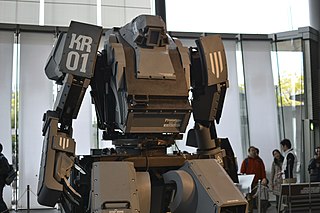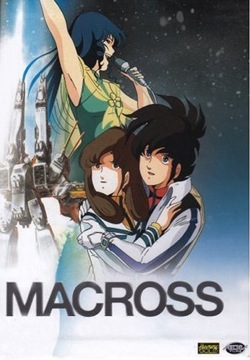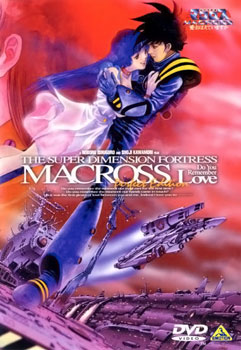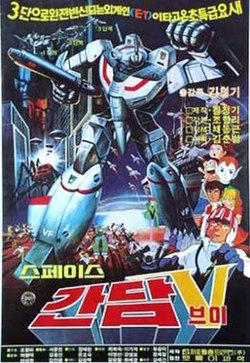
Mobile Suit Gundam, also retrospectively known as First Gundam, Gundam 0079 or simply Gundam '79, is an anime television series, produced and animated by Nippon Sunrise. Created and directed by Yoshiyuki Tomino, it premiered in Japan on Nagoya Broadcasting Network and its affiliated ANN stations on April 7, 1979, and lasted until January 26, 1980, spanning 43 episodes. It was the first Gundam series, which has subsequently been adapted into numerous sequels and spin-offs. Set in the futuristic calendar year "Universal Century" 0079, the plot focuses on the war between the Principality of Zeon and the Earth Federation, with the latter unveiling a new giant robot known as the RX-78-2 Gundam piloted by the teenage civilian mechanic Amuro Ray.

In science fiction, mecha or mechs are giant robots or machines, typically depicted as piloted, humanoid walking vehicles. The term was first used in Japanese after shortening the English loanword 'mechanism' or 'mechanical', but the meaning in Japanese is more inclusive, and 'robot' or 'giant robot' is the narrower term.

Super Dimension Fortress Macross is an anime television series from 1982. According to story creator Shoji Kawamori, it depicts "a love triangle against the backdrop of great battles" during the first Human-alien war. It is the first part of: The Super Dimension trilogy and the Macross franchise.

Macross is a Japanese science fiction mecha anime media franchise/media mix, created by Studio Nue and Artland in 1982. The franchise features a fictional history of Earth and the human race after the year 1999, as well as the history of humanoid civilization in the Milky Way. It consists of four TV series, four movies, six OVAs, one light novel, and five manga series, all sponsored by Big West, in addition to 40 video games set in the Macross universe, two crossover games, and a wide variety of physical merchandise.
Haruhiko Mikimoto is a Japanese anime character designer, illustrator and manga artist. Mostly active during the 1980s, during that decade he rose to prominence and is considered one of the top character designers of his time.

The Super Dimension Fortress Macross: Do You Remember Love?, also known as Macross: Do You Remember Love? or Super Spacefortress Macross, is a 1984 Japanese animated space opera film based on the Macross anime television series.

In the Macross Japanese anime series and its English adaptation Robotech, the first mass-produced transforming aerospace fighter mecha is called the VF-1 Valkyrie. The VF-1 Valkyrie is referred to as a "variable fighter" in Macross.

Super Dimensional Fortress Macross II: Lovers Again is a six episode OVA in the Macross franchise. It was the first installment of Macross to feature a new cast of characters. Macross II was produced by Big West, with no involvement from the original series creators from Studio Nue or the original series animators from Tatsunoko Production.

Shōji Kawamori is a Japanese animation creator and producer, screenwriter, visual artist, and mecha designer. He is best known for creating the Macross mecha animated franchise and the Diaclone toyline, which were in turn the basis for the Robotech and Transformers franchises, respectively. He is also known for creating The Vision of Escaflowne anime series. He pioneered several innovative concepts in his works, such as transforming mecha and virtual idols. His work has had a significant impact on popular culture, both in Japan and internationally.

Hikaru Ichijyo is one of the main fictional characters of the Macross Japanese anime series. His voice actor was Arihiro Hase. After the death of Arihiro Hase in 1996, he was voiced by Kenji Nojima in the PlayStation 2 Macross video game from 2003. In the English dub of the series produced by ADV Films, he is voiced by Vic Mignogna.

Another Century's Episode 2, abbreviated as A.C.E. 2, is a third-person mecha action video game produced by Banpresto and developed by From Software. It is the sequel to the popular 2005 game Another Century's Episode. It was released for the PlayStation 2 on March 30, 2006.

Super Dimension Century Orguss is an anime science fiction series. It inspired an OVA sequel series called Orguss 02. Orguss was the second part of The Super Dimension trilogy from Big West, preceded by The Super Dimension Fortress Macross and followed by The Super Dimension Cavalry Southern Cross.
Kazutaka Watanabe, better known as Kazutaka Miyatake, is a Japanese visual artist and anime designer known for the mechanical design of the Macross TV series and a number of its continuations from Studio Nue, of which he is a founding member. He has also contributed to the mecha design of other series such as Mobile Suit Gundam SEED Destiny.
Mecha, also known as giant robot or simply robot, is a genre of anime and manga that feature mecha in battle. The genre is broken down into two subcategories; "super robot", featuring super-sized, implausible robots, and "real robot", where robots are governed by realistic physics and technological limitations.
Studio Nue, Inc. is a Japanese design studio formed in 1972 by Naoyuki Kato, Kenichi Matsuzaki, Kazutaka Miyatake, and Haruka Takachiho. Crystal Art Studio would change their name to Studio Nue in 1974.

Macross Ace Frontier is a shooting game developed by Artdink for the PlayStation Portable. The game is based on Studio Nue's popular Macross series, one of which is known in the West as the first generation of Robotech. It features original elements as well as characters, mechanics, episode plots and BGM borrowed from 1982's The Super Dimension Fortress Macross original TV series, the 1994 Macross Plus OVA series, the 1994 Macross 7 TV series and the 2008 Macross Frontier TV series, as well as incorporating more elements from the 1984 Macross: Do You Remember Love? feature film and the 2002 prequel OVA series Macross Zero.

Astro Plan, known in China as Space Adventures and informally in Japan as Star Field War Record Astro Plan, is a science fiction mecha animated series created by Guangzhou-based toy firm Xing Yuan. Hailed as "China's first sci-fi animation", the series premiered on Chinese television on January 16, 2010, through Hunan TV's Golden Eagle Channel and ended in mid-February with a total of 26 episodes.
Super Dimension may refer to:

Super Spacefortress Macross is a 1992 vertically scrolling shooter arcade video game developed NMK and published by Banpresto. Based upon the 1984 anime film Macross: Do You Remember Love?, it is the first arcade entry in the Macross franchise. In the game, the players control the VF-1 Valkyrie variable mecha fighters, piloted by Hikaru Ichijyo and Max Jenius, in a battle against the Zentradi alien race.














